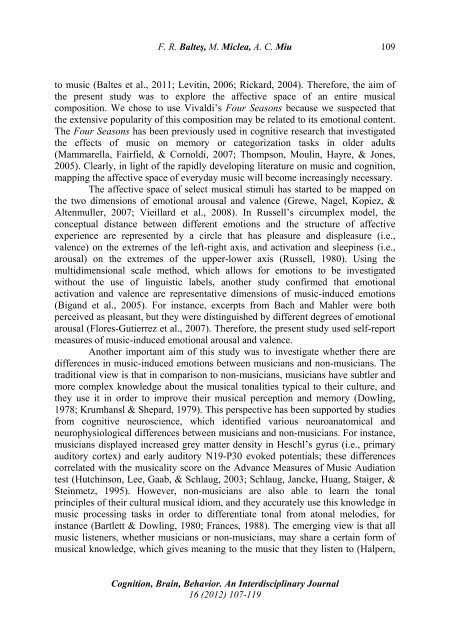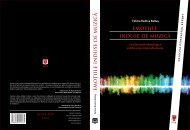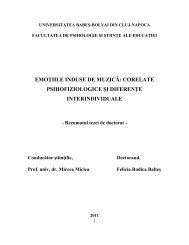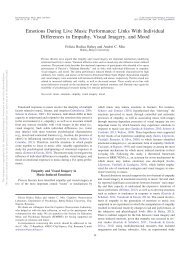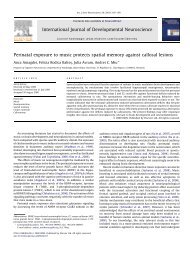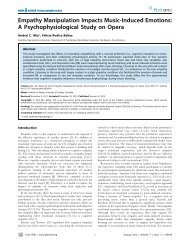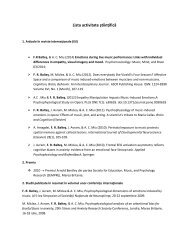o_19k6fnuqsqg41mt7rqp1c8pkueo.pdf
Create successful ePaper yourself
Turn your PDF publications into a flip-book with our unique Google optimized e-Paper software.
F. R. Balteş, M. Miclea, A. C. Miu<br />
109<br />
to music (Baltes et al., 2011; Levitin, 2006; Rickard, 2004). Therefore, the aim of<br />
the present study was to explore the affective space of an entire musical<br />
composition. We chose to use Vivaldi’s Four Seasons because we suspected that<br />
the extensive popularity of this composition may be related to its emotional content.<br />
The Four Seasons has been previously used in cognitive research that investigated<br />
the effects of music on memory or categorization tasks in older adults<br />
(Mammarella, Fairfield, & Cornoldi, 2007; Thompson, Moulin, Hayre, & Jones,<br />
2005). Clearly, in light of the rapidly developing literature on music and cognition,<br />
mapping the affective space of everyday music will become increasingly necessary.<br />
The affective space of select musical stimuli has started to be mapped on<br />
the two dimensions of emotional arousal and valence (Grewe, Nagel, Kopiez, &<br />
Altenmuller, 2007; Vieillard et al., 2008). In Russell’s circumplex model, the<br />
conceptual distance between different emotions and the structure of affective<br />
experience are represented by a circle that has pleasure and displeasure (i.e.,<br />
valence) on the extremes of the left-right axis, and activation and sleepiness (i.e.,<br />
arousal) on the extremes of the upper-lower axis (Russell, 1980). Using the<br />
multidimensional scale method, which allows for emotions to be investigated<br />
without the use of linguistic labels, another study confirmed that emotional<br />
activation and valence are representative dimensions of music-induced emotions<br />
(Bigand et al., 2005). For instance, excerpts from Bach and Mahler were both<br />
perceived as pleasant, but they were distinguished by different degrees of emotional<br />
arousal (Flores-Gutierrez et al., 2007). Therefore, the present study used self-report<br />
measures of music-induced emotional arousal and valence.<br />
Another important aim of this study was to investigate whether there are<br />
differences in music-induced emotions between musicians and non-musicians. The<br />
traditional view is that in comparison to non-musicians, musicians have subtler and<br />
more complex knowledge about the musical tonalities typical to their culture, and<br />
they use it in order to improve their musical perception and memory (Dowling,<br />
1978; Krumhansl & Shepard, 1979). This perspective has been supported by studies<br />
from cognitive neuroscience, which identified various neuroanatomical and<br />
neurophysiological differences between musicians and non-musicians. For instance,<br />
musicians displayed increased grey matter density in Heschl’s gyrus (i.e., primary<br />
auditory cortex) and early auditory N19-P30 evoked potentials; these differences<br />
correlated with the musicality score on the Advance Measures of Music Audiation<br />
test (Hutchinson, Lee, Gaab, & Schlaug, 2003; Schlaug, Jancke, Huang, Staiger, &<br />
Steinmetz, 1995). However, non-musicians are also able to learn the tonal<br />
principles of their cultural musical idiom, and they accurately use this knowledge in<br />
music processing tasks in order to differentiate tonal from atonal melodies, for<br />
instance (Bartlett & Dowling, 1980; Frances, 1988). The emerging view is that all<br />
music listeners, whether musicians or non-musicians, may share a certain form of<br />
musical knowledge, which gives meaning to the music that they listen to (Halpern,<br />
Cognition, Brain, Behavior. An Interdisciplinary Journal<br />
16 (2012) 107-119


